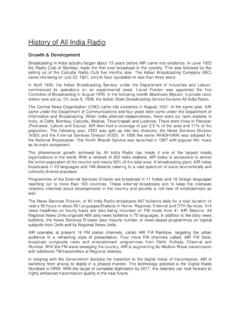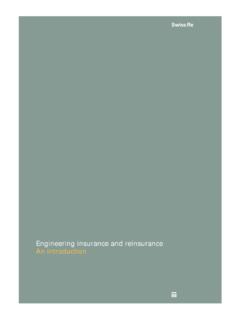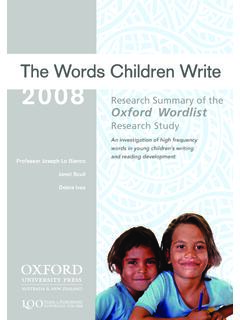Transcription of CHAPTER-4 BASIC CONCEPTS OF PLANNING, DESIGN AND …
1 CHAPTER-4 BASIC CONCEPTS OF PLANNING, DESIGN AND LAYOUT OF AIRPORTS Construction of airport is multi disciplinary project and in it involves the pooling of various engineering disciplines, agencies, experts, contractors, executives and the end users. Before entering into the real case studies of construction of runways and application of supply chain management technique it is essential to built up the CONCEPTS and the general idea about the about airport planning and construction.
2 Airport Planning and DESIGN Fundamentally, the airport is a point of connectivity in the transportation system. At the ends of a trip the airport provides for the change of mode from a ground to air mode or vice versa. As such, the airport is often analyzed using the schematic of Figure. , with the airport s airside consisting of approach airspace, landing aids, runways, taxiways, and aprons, all leading to the gate where the passenger (or cargo) passes through; and the airport s landside consisting of the areas where the passenger (or cargo) is processed for further movement on land: the arrival and departure concourses, baggage handling, curbsides, and access to parking lots, roads, and various forms of transit.
3 Most DESIGN aspects of the airport must reflect the composite understanding of several interrelated factors. Factors include aircraft performance and size, air traffic management, demand for safe and effective operation, the effects of noise on communities, and obstacles on the airways. Various disciplines of engineering are called into use in airport planning and DESIGN . Airport Planning Process Master Plan Airport An airport master plan is a concept of the ultimate development of an airport.
4 This plan is not simply the physical form of the airport development but a description of stage development of the entire airport area, both for aviation and non aviation demand and land use adjacent to the airport, while involving both financial implications and physical studies. The components of a typical airport system are shown in ---. The major components of the system are air side and land side. The terminal building is the major interface between the two components. Following are the objectives of the airport master plan Developing the physical facilities of an airport and future land used in the vicinity of the airport.
5 Establishing schedule of priorities for the implementation of the phase development and improvement proposed in the plan. Establishing the techno-economic and financial feasibility of the proposed development. This should include environmental concerns of the airport operations as well Documenting policies and future aeronautical demand with reference to spending, depth incurrence and land use control. The salient features of ICAO guidelines for a master plan are enumerated in the Table : ICAO guidelines for a master plan of airport Planning step Description Preplanning considerations Coordination, planning, procedure, planning organization, goals and policy objectives.
6 Forecasting for planning purposes Requirements, forecasts required accuracy, methods and principles of forecasting, factors, presentation of forecasts. Financial arrangements and controls Capital costs: currency requirements, source of funds, domestic and foreign financing. Operational costs: source of income, financial control and accounting Site evaluation and selection Land required, location of potential sites, factors affecting airport location, preliminary study of possible sites, site inspection; operational, social and cost considerations, environmental study , review of potential sites, outline plans and estimate of costs and revenues, final evaluation Runway and Taxiways Dimensions, strength, aircraft characteristics, performance and runways length, configuration airfields capacity.
7 Aprons Layout of Aprons, size of stands, parking, service and hanger aprons, holding bays, security, apron accommodation. Air and ground navigational and traffic control aids Visual aids, radio navigation aids and their buildings, demarcation of critical areas, air traffic services search and resume services, apron control communications. Passenger bulding Planning principles, airport traffic and service characteristics, factors effecting scale of services to be supplies, capacity and demand. Cargo facilities Siting, building function and type, apron, facility requirement, access parking, inspection and control Ground transport and internal airport vehicle circulation and parking Private and public transport modes, traffic data, internal roadway circulation curbside, vehicle parking.
8 Airport operation and support facilities Administration and maintenance, medical centre, ground vehicle fuel stations, generating stations, water supply and sanitation, meteorological services, air crew buildings, aircraft maintenance, rescue firefighting , general aviation facilities. Air craft fuel facilities. Security Air side security: roads fencing isolated parking positions, security parking area. Land side security: Passenger buildings, public storage lockers. The individual airport master plan is the cornerstone of the continuing, comprehensive, and cooperative planning process [FAA, 1975].
9 The master plan reflects the complexity and size of the airport. Frequently, the master plan is aimed at solving a specific problem, such as repairing runways, evaluating obstructions, or improving the navigation or terminal landing aids. Physical improvements such as added or extended runways, taxiways, and apron expansion are also identified in the master plan. Airport Planning Issues and Existing Conditions Almost every airport has some deficiency that the airport board or the community or some other airport stakeholder would like to see addressed.
10 These issues can range from improving the capacity (and hence reducing the delay) to a desired improvement in the baggage-handling system. The study is undertaken by first identifying and gathering the issues obtained by examining prior studies and reports and by having in-depth discussions with the all concerned agencies of airport management, the air traffic controller, the airlines, and others involved in the airport use. Next, data are collected on the airport, the airspace infrastructure, and the non aviation areas of airport land use.







